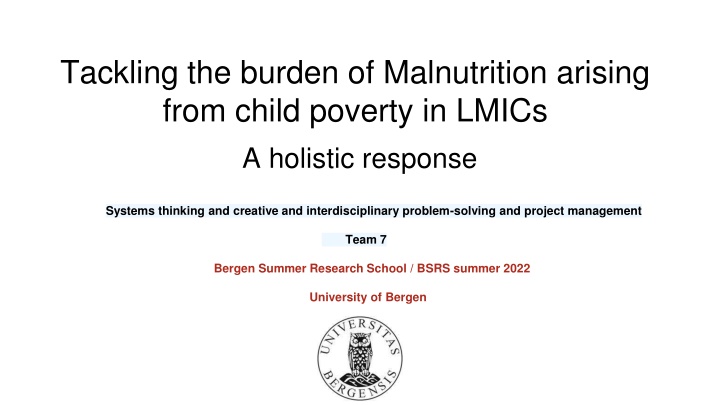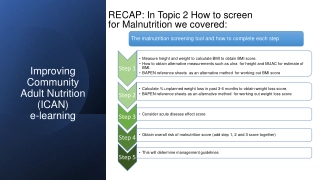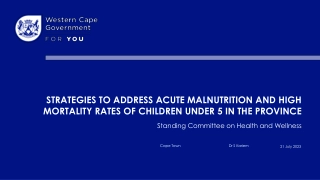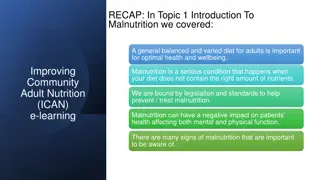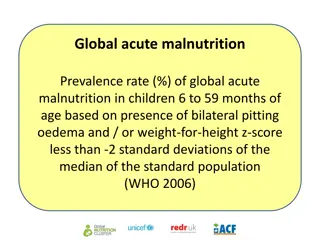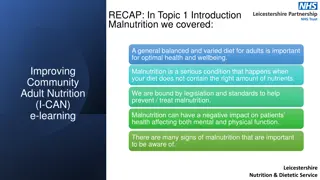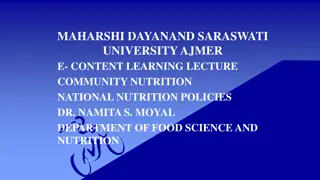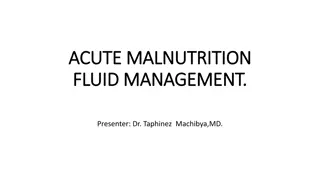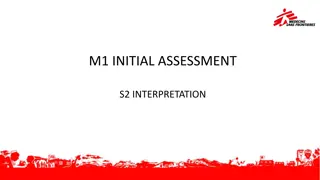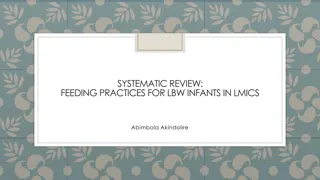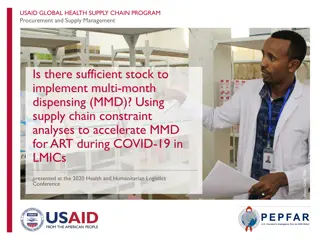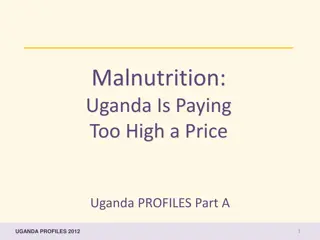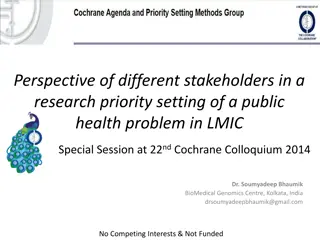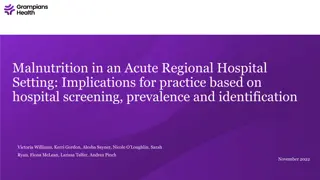Addressing Child Malnutrition in LMICs: A Comprehensive Approach
Tackling child malnutrition stemming from poverty in low- and middle-income countries requires a holistic response, considering factors such as healthcare, education, food security, and social inequalities. This involves understanding the impact on children's health, education, and overall well-being, emphasizing the critical need to combat poverty-related malnutrition for a healthier future generation.
Download Presentation

Please find below an Image/Link to download the presentation.
The content on the website is provided AS IS for your information and personal use only. It may not be sold, licensed, or shared on other websites without obtaining consent from the author.If you encounter any issues during the download, it is possible that the publisher has removed the file from their server.
You are allowed to download the files provided on this website for personal or commercial use, subject to the condition that they are used lawfully. All files are the property of their respective owners.
The content on the website is provided AS IS for your information and personal use only. It may not be sold, licensed, or shared on other websites without obtaining consent from the author.
E N D
Presentation Transcript
Tackling the burden of Malnutrition arising from child poverty in LMICs A holistic response Systems thinking and creative and interdisciplinary problem-solving and project management Team 7 Bergen Summer Research School / BSRS summer 2022 University of Bergen
Causes of Poverty Lack of Vestibulum congue Vestibulum congue good healthcare Lack of good healthcare Vestibulum congue Lack of Lack of Vestibulum congue Vestibulum congue food and water Vestibulum congue Vestibulum congue good education Vestibulum nec Poverty Poverty congue tempus High costs Lack of food and water Vestibulum congue Vestibulum congue Lack of government support Vestibulum congue High costs Vestibulum congue Vestibulum congue
Inequality and malnutrition The burden of malnutrition is an inherent reflection of inequalities around the world. It reflects a double burden of undernutrition and overnutrition (obesity). These existent inequalities creates a class system that segregates society into the high, middle, and lower class. Most of the people that make up lower class live in entrenched poverty.
Children and malnutrition The most vulnerable group affected by malnutrition arising from poverty are children. Children in mostly LMICs are highly predisposed to disadvantages associated with malnutrition deriving from child poverty. Malnutrition affects other aspects of children s lives such as health status or access to education, among others. Most contributing factors to child malnutrition include: level of knowledge about malnutrition, access to nutritious healthy and safe foods, willingness to invest in nutritious foods, housing conditions, sanitation, food security, and access to safe clean water.
Why does malnutrition matter in responding to child poverty POVERTY Encompases more than low income. It also includes poor health and sanitation facilities, lack of education and denial of rights. Linkage between Poverty and Child Malnutrition CHILD MALNUTRITION Malnutrition starts in the womb and becomes evident after birth, it manifests into adolescence and becomes critical during adulthood. Woman suffering from malnutrition have higher risk of bearing underweight babies. Affected nutrition throughout life. Increased exposures to environmental risks, diseases, and diminishing of learning abilities.
Our Policy position Our policy action plan is centered on tackling child malnutrition arising from poverty by taking into consideration: Knowledge and awareness of people on importance of diet quality and early life nutrition. The unique social, cultural, and economic realities across societies in LMICs. The existent realities of the food environment in each LMICs and how it can be sustainable developed.
Recommended action plan for family of LMICs Work on programs and campaigns that promote family education on the importance of diet quality and early life nutrition on child development and wellbeing Involving the family as a major stakeholder to child development in making meaningful contributions to policy planning and designs while taking into consideration their unique social, economic, and cultural realities. Enabling household subsistence farming of organic food.
Recommended action plan for civil society of LMICs Stakeholders must work in coordination to overcome barriers that are holding back progress to end malnutrition. Build equitable, resilient and sustainable food and health systems- invest in nutrition - focus on joint efforts - strengthen accountability. Build an infrastructure of nutrition experts that can educate and assist the population. Focus on bottom-up approaches - local production, local procurement and equitable distribution - local governments should be given power and should be made accountable and responsible.
Recommended action plan for the government in LMICs Incorporate nutrition-education into the curricula during first and second level education. Ensure that healthy and sustainably produced food is accessible and affordable for all. Improve agricultural subsidies and increase public investment for producing diverse and healthier foods.
Recommended action plan for the International community Create a global knowledge data bank that provides right information on food education to aid awareness and increase knowledge of all especially in LMICs. Subsidise low and middle income countries during the natural disasters and help them promote the infrastructure level. Providing donor funds that will improve the agricultural and food environment especially in LMICs. Create policies that will encourage import and export of healthy foods across the world. We need policy reforms which dismantles monoculture farming and accelerate movement towards agro-ecological farming
Specific programs Providing free meal (B tikofer, M lland & Salvanes 2018; Lungborg et al. 2022) and food stamp program (Almond et al. 2016) for both children and pregnant women in poor household. Healthcare centers and nutrition advices (B tikofer, L ken & Salvanes 2018) Pharmaceuticals and vaccines (Bharadwasj, L ken & Nielson 2013; Lee Luca, 2016) Nudging healthy food choices: putting healthy food in a more salient place while keeping unhealthy food available in unsalient places (Kroese et al. 2015) More research to be conducted to mainstream the production of crops that are marginally cultivated in regions with limited resources (Muthamilarasan and Prasad, 2021) like small millets which is cheap, easy to grow, environment friendly and excellent source of nutrition which supports sustainable agriculture (Banerjee and Maitra, 2020) This ensures diversity in food
Conclusion Source: https://scalingupnutrition.org/nutrition/nutrition-and-the-sustainable-development-goals/ accessed on 15.06.2022.
Reference Hoynes, H., Schanzenbach, D. W., & Almond, D. (2016). Long-run impacts of childhood access to the safety net. American Economic Review, 106(4), 903-34. Lundborg, P., Rooth, D. O., & Alex-Petersen, J. (2022). Long-term effects of childhood nutrition: Evidence from a school lunch reform. The Review of Economic Studies, 89(2), 876-908. B tikofer, A., M lland, E., & Salvanes, K. G. (2018). Childhood nutrition and labor market outcomes: Evidence from a school breakfast program. Journal of Public Economics, 168, 62-80. Muthamilarasan, M and Prasad, M. (2021). Small Millets for Enduring Food Security Amidst Pandemics,Trends in Plant Science, 26(1), 33-40. https://doi.org/10.1016/j.tplants.2020.08.008 Banerjee, P. and Maitra, S. (2020). The Role of Small Millets as Functional Food to Combat Malnutrition in Developing Countries, Indian Journal of Natural Sciences, 10(60), 20412-20417. B tikofer, A., L ken, K. V., & Salvanes, K. G. (2019). Infant health care and long-term outcomes. Review of Economics and Statistics, 101(2), 341- 354.
